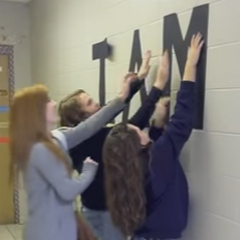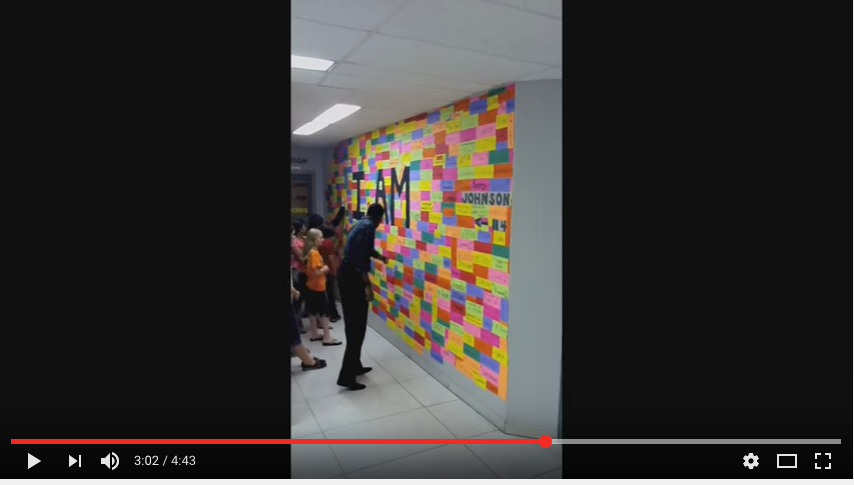This student project stemmed from an 8th grade language arts class at Liberty Middle School reading The Outsiders by S.E. Hinton. We spent many months discussing how we can “shatter” stereotypes in our society. The video features “Iron Doors” by The Lighthouse and the Whaler. – Ambra Johnson, language arts teacher
By Devin Acklin, Joyce Jung, Justin Locke & Sara Thorsness
(Contributing Students)
The “I Am” wall originally started as a language arts class project for individual students to shatter the stereotypes that they felt have been placed on them. Before starting on the project, we personally felt confused and unenthusiastic towards this prompt, because it seemed awkward projecting our personal struggles in front of teachers and peers.
“Why should I share my life with others?” It seemed invasive and uncomfortable because students aren’t normally prone to sharing their troubles in a public environment.
One day, Ms. Johnson had us all write down ways that we are judged – personal stereotypes – the things that we are NOT – on strips of black and white paper. We moved our desks to a circle, and Ms. Johnson laid out all of the stereotypes (the “I am not…” strips) in the center of the room. We had no idea who wrote what on each piece of paper, but we silently read those words and phrases scattered across the floor:
I AM NOT …. always quiet / boring / just a band nerd / rich / a know-it-all / Muslim / helpless / who you think I am / always happy / racist / sure of myself / an American native / often included / indestructible / easy / afraid to live my dreams / always trying my best / a loser / fake / listening to you scream at me / a Christian / perfect / and so on.
Ms. Johnson asked us to reflect on what was laying on the floor. We could pick any three strips of paper that we could relate to the most, and we had to write about why we connected to those words. We then had to write about how we can shatter these stereotypes or explain some of the ways we can show the world we aren’t these things.
This was a little bit awkward because we aren’t used to teachers asking us to think this deeply about something that is not really “school related,” but after we got comfortable, everyone started writing and didn’t stop until she made us.
The “I Am” statements
 After the first activity, we focused on the things that we really are. The “I am. . .” statements. We tweeted articles and videos on Twitter using the hashtag #lmsthinksbig about different stereotypes of different people.
After the first activity, we focused on the things that we really are. The “I am. . .” statements. We tweeted articles and videos on Twitter using the hashtag #lmsthinksbig about different stereotypes of different people.
For example, one day someone tweeted a news article about how adults (you) consider Generation Z (us) “lazy” and “apathetic.” We had conversations in the classroom with each other and with others via Twitter—other students, our assistant principal, a parent, a retired guy in Kentucky we didn’t know – about why teens are judged like this.
The use of Twitter really enticed us as students to take interest in participating in the activity and motivated us to start taking actions to change the world.
Building the wall
Next, we began to make “I AM…” statements to create a wall outside of room 114. If you come by and look at our wall, you will see such a wide variety of words and phrases:
I AM…
a person / funny / creative / full of anxiety / biracial / an overthinker / trying to find the right path / tired / faithful / reliable / different / bilingual / heartbroken / wanting more / real / a person with anger issues / minus two grandparents / Indian / afraid of meeting new people / misunderstood/ Christian / someone who makes mistakes / athletic / Egyptian / adopted / ADHD / artistically disabled / pressured / tired of cancer / talented / about to crumble / a brother and a son / forgiving / a person who laughs to keep from crying / a dreamer / here for you / a Mormon / stressed / unsure of where I belong / persistent / a person with anger issues / heartbroken / constantly worrying / here for a purpose / clumsy / sad / Turkish / younger than you / trying to find the right path/ bad with change / unwanted / trying my best to learn English / vulnerable / insightful / more than you think I am…
At first, the wall seemed insignificant because it looked like there was no organization or focus or concern for more emotional and abstract connections. However, as the project progressed, we believe that it acted as an eye opener to others’ similar issues.
It was fun to see students from other teams coming up to our hallway wanting to add to our wall, asking for paper and sharpies, reading what was already up there, and really being interested in it. As the wall continued to grow, different students from Team 8 would be in charge of recording using the iPad to document the wall going up. It seemed like the school was taking notice of us and our statements.
More people started coming up to us, asking us what it was and asking about #lmsthinksbig. As awareness grew, our classes bonded closer together, and we think our peers genuinely began to learn what it meant to empathize with others. We can’t speak for the teachers, but it is obvious that other students’ struggles were not so different from our own.
A new perspective on the project
A few weeks after starting the project, our team started reading The Outsiders by S.E. Hinton in class, and this is when we started realizing where all of this stereotyping stuff came from. The main characters in the novel are labeled because of their social class.
We didn’t realize it at the time, but when we were making statements such as “I am labeled,” “I am worried about my future,” “I am courageous,” “I am unsure of my potential,” “I am scared,” “I am sometimes hiding behind my sadness,” “I am a dreamer,” “I am looking for solid ground,” etc., we were writing the same statements that Ponyboy Curtis, Dallas Winston, or Johnny Cade would have written if they were sitting in Ms. Johnson’s language arts class. By picking out “I am…” and “I am not…” statements from the walls about each character, this really made us look at the project and the characters from a different perspective.
The purpose of the wall is to eliminate stereotypes and appreciate the differences in others. If we could describe this wall in one way, it would be “bravery” because students had to be so brave to put personal things on a wall in school where everyone can see.
We learned that we are all alike much more than we realized. It is awesome to see our friends retweet pictures and the video of our wall. Ms. Johnson emailed a band from Ohio called The Lighthouse and the Whaler to see if we could use one of their songs, “Iron Doors,” for our video. They agreed, and a few weeks later they started tweeting with us and even retweeted our video which is awesome because they have a lot more followers than we do, so people in different parts of our country are now watching our video.
We keep discovering things
The wall has stretched beyond room 114, Liberty Middle School, and even Madison, Alabama. We have learned about “digital citizenship” and “global citizens” and things like that, but we think this a real example of taking those terms and applying them to show everyone how our voice can be heard.
We are very proud of the project because it took a lot of courage and hard work to complete it. Well, complete may be the wrong word. We don’t think it will ever be completely complete. It seems that we keep discovering things about ourselves every day, so all we need to strive for is to be ourselves. There is no one exactly like us out there, and this wall serves as a visual representation and reminder to us to “stay gold” and to always “be” us.


0 Comments on "The Story Behind the “I Am” Wall"